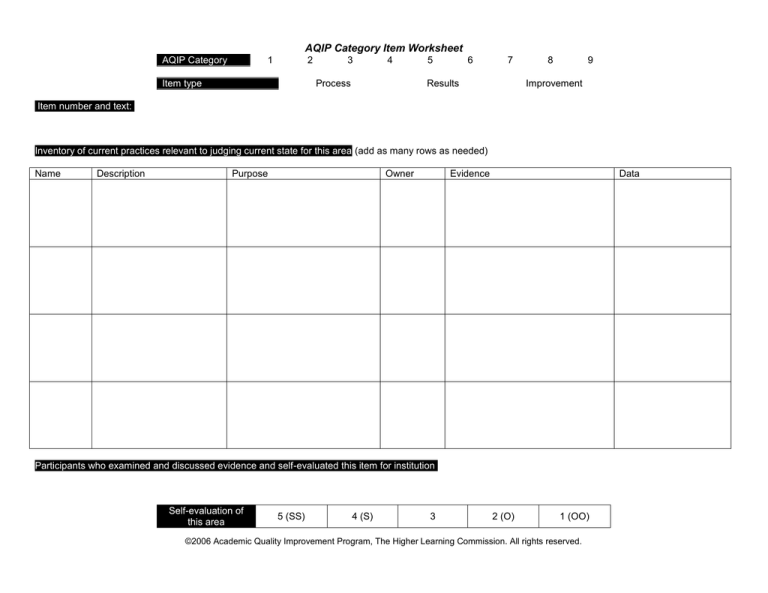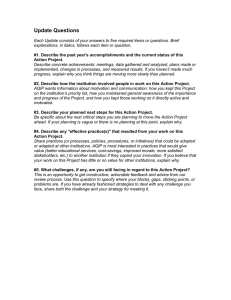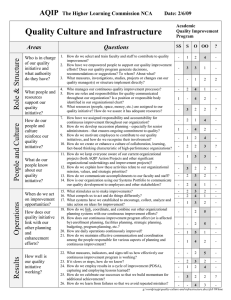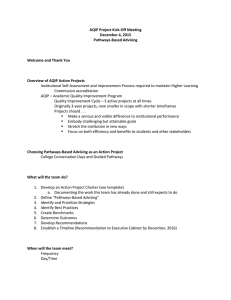
AQIP Category Item Worksheet
AQIP Category
1
2
Item type
3
4
Process
5
6
7
Results
8
9
Improvement
Item number and text:
Inventory of current practices relevant to judging current state for this area (add as many rows as needed)
Name
Description
Purpose
Owner
Evidence
Data
Participants who examined and discussed evidence and self-evaluated this item for institution
Self-evaluation of
this area
5 (SS)
4 (S)
3
2 (O)
1 (OO)
©2006 Academic Quality Improvement Program, The Higher Learning Commission. All rights reserved.
Current Projects that would affect this item:
Summary evaluation and rationale:
Unresolved issues and ideas for future projects that would affect this item:
AQIP Category
Circle the number of the AQIP Category from which this item comes
Item Type
Circle a word to indicate whether this is a C, P, R, or I item
Item Number and Text
Copy, verbatim from the AQIP Categories, the item number and text of the item.
Inventory of Evidence relevant to determining the current status of this area
o List all of the institutional activities, programs, policies, structure, etc. that together constitute your institution’s ways of addressing the issues or needs
included in this item. (If this is an I [Improvement] item, include information on systematic procedures the institution uses to identify improvement
opportunities and capitalize upon them.)
For each practice listed, indicate:
o Name – give the practice a short name that everyone can use to refer to it (e.g., Annual Personnel Review, Student Housing Office, No Smoking Policy,
Fall In-Service Day)
o Description – write a sentence that concisely describes the practice (who does it, when, where, how). If the Name says it all, skip the description. Purpose
or goal - summarize in a sentence the objective of the practice – what it is supposed to accomplish or achieve. (this may not be clear — if so, write
“unsure”)
o Owner – identify the owner or controller of this practice: the person, unit, or group that could change it if it needed to be changed.
o Evidence – the location of primary documents (policies, reports, etc.) that represent this activity. This might be a web or server link to the documents.
o Data -- If this is an R (Results) item, include data sets (and the methods by which they are collected) measuring stakeholder needs, satisfaction, and
outcomes, or institutional performance.
If this is an I (Improvement) item, include data on specific improvements made as a result of these procedures over the past few years.
Some practices you need to include in this inventory are:
o Activities (e.g. Convocation Day, Finals Week, Tuesday Night Movies)
o Programs (e.g. Freshman Composition, Advisement, Staff Development)
o Policies (minimum requirements for a bachelors degree, tenure and promotion policies)
o Structures (Student Affairs, the Chemistry Department, The Humanities Division, College of Art)
Who participated in examining the evidence and self-evaluating this area?
Record the names and position titles of all participants.
Current self-evaluation of this area
Evaluate the area, overall, on a five point scale: SS to OO with neutral midpoint (neither a strength nor an opportunity). SS=Major strength, S=Strength,
O=Opportunity for improvement, etc.
Current projects that would affect this item
If work is underway on changes that would materially affect how you judge this item, note them here, and discuss their impact in your summary evaluation.
Summary evaluation
Summarize your self-evaluation and the reasoning behind it, identifying the practices or factors that were the major pluses and minuses in your overall judgment.
Identify practices that weighed the most heavily on your self-evaluation.
Unresolved issues and ideas for future projects:
Note here any issues that remain unresolved from you deliberation (e.g., where evidence was missing that prevented you from including a practice in your selfassessment) as well as ideas for future improvement projects related to this Category item.



